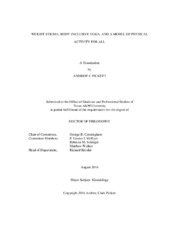| dc.description.abstract | Individuals in larger bodies face high levels of stigma in modern society, based largely on societal assumption about the relationships between body size and personal health choices and behaviors. Given the cultural stigma of fatness and perceptions that fat individuals can and should lose weight through exercise, physical activity (PA) spaces are particularly hostile towards fat bodies. This hostility creates a strong barrier to participation in PA for those in larger bodies, despite the fact that all individuals can benefit from engaging in regular activity. Therefore, this dissertation research is designed to develop a new, more inclusive model of PA for those in larger bodies.
In Study 1, I develop a framework of inclusive organizational behaviors for PA spaces, arguing that individuals engaged in activity in these spaces are more likely to experience increased identification and improved physical and psychological health through adherence. The resulting model, drawn from various literature, provided six factors of inclusion for PA organizations. In the second study, I examined the practices of body-inclusive yoga spaces, through a series of qualitative interviews with their leaders. These leaders supported many of the previously outlined factors of body-inclusive PA and added two new factors. In Study 3, I developed a measure of body inclusivity, based on the six resulting factor model developed in the previous study. Each of the six factors tested (i.e., authentic leadership, cultural commitment to inclusion, health focus, inclusive language, social justice activism, and sense of community) were positively related to overall body inclusivity. Further analysis, using structural equation modeling, indicated that body-inclusivity of PA spaces was positively related to overall physical and psychological health. Further, the relationship between inclusion and psychological health was partially mediated by identification with the activity, which was also positively related to inclusivity.
Taken together, these studies provide evidence to a simple notion: inclusion works. In developing a more inclusive PA environment, individuals experienced greater identification with activity and improved health, thereby demonstrating the tangible value of inclusive practices. Implications for sport and PA mangers, as well as directions for further research, are discussed. | en |


